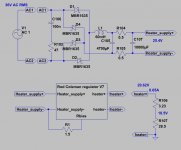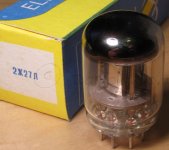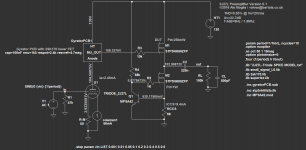but next step will be choke input for that as well.
For choke input you must to use at least 36-38V AC transformer.
For choke input you must to use at least 36-38V AC transformer.
Yes - around that. It may be a bit less. I'll try 31v secondary first and see where I get with that - 25v and 6v in series. Then I can try 25v and 9v in series. When I have the right value I'll order from JMS. They do a good value 100VA transformer and you can specify the secondary.
1 PH Trans
There may be some off the shelf EI transformers at 18+18v, but JMS looks better value.
I simulated a bit...with 36V AC you will on the border (old version R.C. regulators need at least 5V over output voltage).
Reichelt.de has 2*18V transformers (I use 100VA ones for 1-2A R.C. regulators).
http://www.reichelt.de/Transformers...wQATMAAC5pJ-M1bc1b1422f91e4623a28bf094a9c960c
Reichelt.de has 2*18V transformers (I use 100VA ones for 1-2A R.C. regulators).
http://www.reichelt.de/Transformers...wQATMAAC5pJ-M1bc1b1422f91e4623a28bf094a9c960c
Attachments
Last edited:
I see 4P1L took it's deserved place.
Now, one more sleeper: 2J27L -- still cheap as a dirt.
Very nice in triode mode, for preamps. Much lower microphonics than 4P1L
2J27L / 4P700 / RV2 HF RUSSIAN PENTODE TUBE NOS Lot of 30
Now, one more sleeper: 2J27L -- still cheap as a dirt.
Very nice in triode mode, for preamps. Much lower microphonics than 4P1L
2J27L / 4P700 / RV2 HF RUSSIAN PENTODE TUBE NOS Lot of 30
Nice looking tube indeed. Some more info from Ale
2Z27L triode | Bartola Valves
mu of 16, low heating current, interesting! Maybe with a gyrator load? Would have to use somewhat higher B+ to reduce distortion. I think the datasheet says max plate dissipation is 1W and 0.3W on G2??
http://www.klausmobile.narod.ru/td/data/_2j27l.GIF
2Z27L triode | Bartola Valves
mu of 16, low heating current, interesting! Maybe with a gyrator load? Would have to use somewhat higher B+ to reduce distortion. I think the datasheet says max plate dissipation is 1W and 0.3W on G2??
http://www.klausmobile.narod.ru/td/data/_2j27l.GIF
HI Erik,
Yes, a beautiful candidate for a preamp when more gain is needed. I tested this back in 2012. This valve is not as linear as 01a/4P1L and others but will perform really well as preamp if a follower is added to avoid slew rate issues when driving challenging loads
Here is an idea for a nice DHT preamp. The simulation below correlates well with my measurements here
Let's see how the price rockets up shortly
Ale
Yes, a beautiful candidate for a preamp when more gain is needed. I tested this back in 2012. This valve is not as linear as 01a/4P1L and others but will perform really well as preamp if a follower is added to avoid slew rate issues when driving challenging loads
Here is an idea for a nice DHT preamp. The simulation below correlates well with my measurements here
Let's see how the price rockets up shortly
Ale
Attachments
And you're probably right that it could be run hotter to improve distortion performance. I will build it as-is and listen to it. The use of the output follower is a must given the low current and anode resistance of this little fellow.
With 56mA filament demand I guess a set of batteries would work, but there is a hassle in re-charging them. Been there done that. Thomas Mayer implemented the 01a with filament current derived from the HT. This could be done with a DN2540 CCS to the HT but then the HT needs to be sized to manage +120mA and also a considerable heatsink for each CCS (6-7W of heat dissipation per channel)
just some thoughts...
With 56mA filament demand I guess a set of batteries would work, but there is a hassle in re-charging them. Been there done that. Thomas Mayer implemented the 01a with filament current derived from the HT. This could be done with a DN2540 CCS to the HT but then the HT needs to be sized to manage +120mA and also a considerable heatsink for each CCS (6-7W of heat dissipation per channel)
just some thoughts...
Hi Mogliaa,
I would love to try these out, as I have indeed been looking for a DHT with some more gain and with less demanding filament demands - it is just that our 1.5 year old Sophia demands as much attention as your Sofia - and DIY time is therefore severely reduced.
Cheers! Erik
I would love to try these out, as I have indeed been looking for a DHT with some more gain and with less demanding filament demands - it is just that our 1.5 year old Sophia demands as much attention as your Sofia - and DIY time is therefore severely reduced.
Cheers! Erik
Nice looking tube indeed. Some more info from Ale
2Z27L triode | Bartola Valves
mu of 16, low heating current, interesting! Maybe with a gyrator load? Would have to use somewhat higher B+ to reduce distortion. I think the datasheet says max plate dissipation is 1W and 0.3W on G2??
http://www.klausmobile.narod.ru/td/data/_2j27l.GIF
2Z27L has a very low current filament and medium mu which may be problematic WRT microphony . 2P29L is another Soviet small signal DHP with mu of 8 , Ra 5K as a triode . Probably a good substitute for a type 26
316a
2Z27L has a very low current filament and medium mu which may be problematic WRT microphony . 2P29L is another Soviet small signal DHP with mu of 8 , Ra 5K as a triode . Probably a good substitute for a type 26
316a
The Russians have been there before us in most cases. There are enough audio geeks in Russia to have already gone through the likely suspects, and they have audio forums in Russian as well where they discuss tubes. It may be tempting to think we can "discover" some sleeper but there have probably been a few feet in the snow before us.
I got some 6P21S thinking they looked promising but they were nowhere near as good sounding as the 4P1L in the experiments I made. The 4P1L is the star of the show for me, both as input and as output tube.
Hi Anatoliy, interesting topology. Do you have an estimate on input sensitivity and output power rating? It's a pity that I can't read the labels. I'd appreciate a larger picture or a link to it for reference. Thanks.Here is from Russian forum: 2P29L driving 4P1L
Hi Anatoliy, interesting topology. Do you have an estimate on input sensitivity and output power rating? It's a pity that I can't read the labels. I'd appreciate a larger picture or a link to it for reference. Thanks.
It was not mine. But you can estimate calculating input impedance of the output stage, using voltage amplification factor of 4P1L on the giving load. Then divide feedback resistance on it. You are getting load resistance (in parallel with anode load resistor). Knowing Gm of the 2P29L and it's load resistance yo can get it's amplification factor, then multiply it by an amplification factor of the output tube with local feedback, then divide it by a transformer ratio.
If I could only see the values of the parts used. But thanks anyway.But you can estimate calculating input impedance of the output stage ...
- Home
- Amplifiers
- Tubes / Valves
- One more 4P1L SE




